These activity sheets define the five different types of conditionals (zero, one, two, three, and mixed) used to express circumstances, desires, and more. Your students will learn how to identify these conditionals by marking given phrases, writing their own, choosing the correct verb tenses to complete the conditional, etc. Where definitive answers are required, answer keys have been provided for the instructor, but please note that in some activities, the students' answers will vary. Teacher Tip: Discuss how conditionals can also reflect different moods in English, such as the subjunctive mood. (Note: this can get confusing for beginning students.)
Print Conditional Word Worksheets
Click the buttons to print each worksheet and associated answer key.



Conditionals Type 1
Fill in the blank with the correct words. This will be very rewarding towards understandin this skill as a whole.

Second Conditional Structure
The second conditional structure is used to talk about unreal situations (things that aren't possible; things that won’t happen) in the present.

Third Conditional Structure
The third conditional structure is used to talk about unreal situations (things that were impossible; things that didn't happen, etc.) in the past.

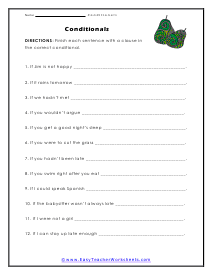
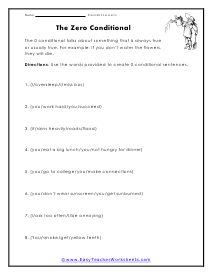
Creating a Zero Conditional
The 0 conditional talks about something that is always true or usually true. For example: If you don’t water the flowers, they will die.
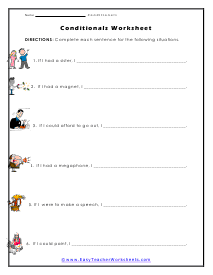
The Situation
Complete each sentence for the following situations that makes the greatest level of sense given the parameter of the conditions that surround the situation.
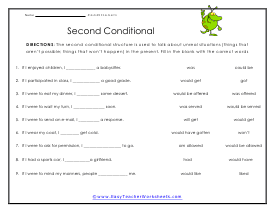
Secondary Conditionals
The second conditional structure is used to talk about unreal situations (things that aren't possible; things that won't happen) in the present.
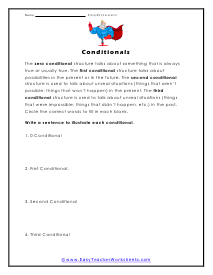
Levels and Layers
Write a sentence to illustrate each conditional. Then think further and expect more out of yourself and your classmates.
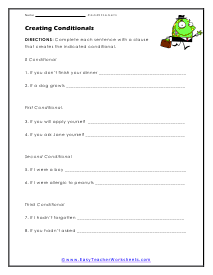
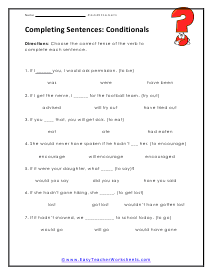
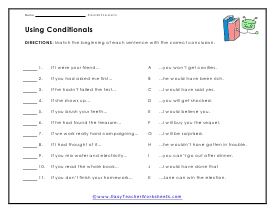
What is Conditional Language?
Conditional language refers to phrases that describe the relationships between two things or ideas as dependent on another factor. In English, these relationships are often shown using if clauses and conjunctions like unless, before, until, as long as, and given that, and can also be implied through context or other grammatical choices. The use of conditional language in English literature has a long history, dating back centuries before the invention of conditionals as we know them today in written language.
We use conditional language to discuss hypothetical situations and what the outcomes may be. We often do this when planning something. These sentences often contain the conditional word if. There are four different types of conditional sentences that you will come across. We will use these forms for different purposes and to maintain proper grammar and mechanics in our sentences. Zero conditionals are used for present and real situations. They are used when the clause and main verb tense are both in simple present form. First conditionals are used for real future situations. You will find this form of usage when the clause verb tense is in the simple present and the main clause verb tense in the future form. Second conditionals are used for present or future imaginary situations. Third conditionals are used for past imaginary situations. These forms can also be presented in a mixed setting. Punctuation is the key for these types of sentences, but a simple rule applies. When the if-clause paves the way for the main clause, place a comma after it. It the main clause leads the if-clause, no need for punctuation.<br>
Whether you're reading Shakespeare or analyzing The Great Gatsby, understanding how conditional language is used in literature can help you engage with it on deeper levels. If and then are two commonly used conditional conjunctions, along with unless, as, and when, among others. Many of these words are often used interchangeably by writers and readers alike, so let's look at how they differ in this lesson on conditional language in English literature.
The Basics of Conditional Language
Conditional language refers to verbs suggesting conditionality, such as would, should, could, and might. It is often used for hypothetical situations; for example, a student might say he would visit his professor if he had more time.
What is the Use of this Language in Literature?
Conditional language is also commonly found in literature--particularly fiction and drama--and can serve as a literary device that shapes the tone and style of storytelling. The use of conditional language allows authors to inject suspense into their work by giving readers an idea of what may happen without directly telling them.
For instance, an author may write about a character who says she would have been angry at her friend's betrayal if she hadn't already known about it beforehand. This way, readers are given insight into how characters think and feel without being told outright.
Authors also use conditional language in order to discuss hypothetical or alternate realities within their works--for example, what happens when two lovers part ways or whether someone will become rich after winning a lottery jackpot.
Varying Degrees of Conditional Language
The three most common types of conditional sentences in literature are third-type conditionals, second-type conditionals, and first-type conditionals. A third-type conditional is defined as a statement that relies on an uncertain event or outcome. The opposite of third-type conditionals is expressed by what is called zero conditional language, which employs absolute language without reference to events or conditions. Second- and first-type conditionals refer to hypothetical outcomes that could have been determined if certain steps had been taken.
Examples of Conditional Sentences:
Conditional sentences are what happens when we use language with if and when. These can be tricky because we don't always remember that these sentences aren't absolutes but rather possibilities for what could happen if certain events occur. Let's take a look at a few examples:
- If I had a million dollars, I would donate a lot of it.
- If I could travel back in time, I would like to see where my parents met.
- I will help you if you need me.
Tips on How You Can Properly Use Conditional Language:
The best way to use conditionals effortlessly is to completely understand their reasoning. Also, if you'd want some pointers on how to become proficient with conditionals, here are a few tips:
- Watch out for your grammar and tenses.
- Pay attention to how native speakers use them in conversation.
- The sequence of clauses isn't set in stone, so try to be creative.
Ending Notes:
Conditional language is common in everyday speech. If you want your writing to be clear and concise, using conditional language will help you achieve that goal.
Consider using conditional language next time you write an essay, article, or book, and see how effective it can be! Have fun with it!


